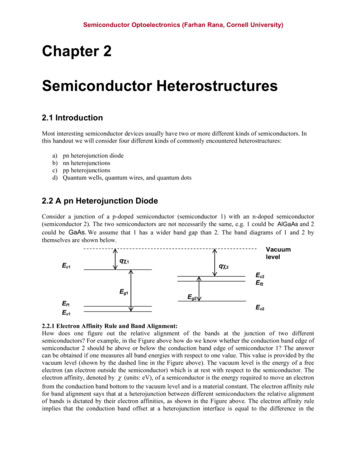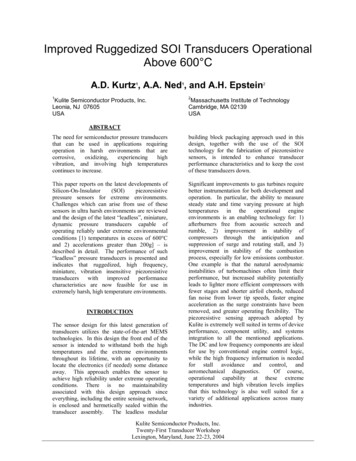
Transcription
2020STATE OFTHE U.S.SEMICONDUCTORINDUSTRY
INTRODUCTIONWITH TRANSISTORS 10,000TIMES THINNER THAN A HUMANHAIR – SO SMALL BILLIONSCAN FIT ON A CHIP THE SIZEOF A QUARTER – TODAY’SSEMICONDUCTORS ARE ATRIUMPH OF INNOVATIONAND A HALLMARK OFAMERICA’S TECHNOLOGICALPROWESS.U.S. companies have for decades led theworld in producing these tiny chips that powermodern technologies. Our country’s leadershipin semiconductors is a big reason America hasthe world’s largest economy and most advancedtechnologies.These industry investments have sustained U.S.leadership in semiconductor innovation. U.S.companies are leaders in 5G technology and havedeveloped virtually all the advanced semiconductorsrelevant for AI and big data, which power everythingfrom supercomputers to Internet data centers.Since the onset in early 2020 of the COVID-19pandemic, semiconductor-enabled technology hasbeen deployed to find treatments, care for patients,work and study from home, order groceries andother essential products, and sustain countlessother systems that underpin modern society. It is areminder of the importance of semiconductors inresponding to the world’s most urgent challengesand crises.The U.S. industry, however, faces a range ofchallenges. The COVID-19 pandemic has upendedthe global economy and disrupted worldwidesupply chains, causing significant near-termmarket uncertainty. The rising cost of innovationfor semiconductor manufacturing and design,particularly at the leading edge, continues to posechallenges. Additionally, while the U.S. remains theglobal leader in semiconductor design and R&D, thelion’s share of chip manufacturing is now occurringin Asia. Finally, global geopolitical instability,especially regarding trade policy, is forcing the U.S.industry to consider how to remain competitivein a world of unforeseen uncertainty and policyconstraints. The U.S. semiconductor industry relieson its deep global supply chains and access tooverseas markets.The U.S. semiconductor industry has continuedto maintain its global leadership position insemiconductor technologies essential for thefuture, including artificial intelligence (AI), quantumcomputing, and advanced wireless networks suchas 5G. The U.S. semiconductor industry has alsomaintained its global market share leadership, eventhough worldwide year-over-year sales growth in2019 was negative, and has kept steady its very highlevels of investment in research and development(R&D) and capital expenditure (capex).2 SEMICONDUCTOR INDUSTRY ASSOCIATIONOverall, while the U.S. industry continues to lead theglobal industry, it also faces clear challenges as itseeks to maintain its leadership into the future.
THE GLOBALSEMICONDUCTOR MARKETFifty years ago, semiconductors helped put people on the moon and got them back homesafely. More recently, semiconductors have made it possible to make autonomous vehiclesa viable near-term technology. Semiconductors have become essential to the operationof everything from the economy to national security. Market demand for semiconductorsis fundamentally linked to how chips continue to bring new conveniences to our world,making the impossible possible. This is why the semiconductor industry’s long-term growthprospects remain bright. In the near-term, however, the COVID-19 pandemic and othermacroeconomic factors present significant uncertainty.Following record sales in 2018, the global market decreased in 2019, and theoutlook for 2020 has been negatively affected by the COVID-19 pandemic.Following record sales of 468.8 billion in 2018, globalsales in 2019 decreased by 12 percent to 412.3 billion,due largely to cyclicality in the memory market.The World Semiconductor Trade Statistics (WSTS)Semiconductor Market Forecast released in June 2020projected worldwide semiconductor industry sales willincrease slightly to 426 in 2020, a downward revisionfrom its Fall 2019 forecast for 2020, due mainly to thenegative impact of the COVID-19 pandemic on the globaleconomy and supply chains at the start of 2020. In 2021,WSTS forecasts global sales will rebound to 452 billion.GLOBAL SEMICONDUCTOR SALES ( B)500450400350300250200-12.1% ’05’06’07’08 ’192020 STATE OF THE U.S. SEMICONDUCTOR INDUSTRY 3
SEMICONDUCTORDEMAND DRIVERSSemiconductors enable a wide variety of products, from smartphones andcomputers to cars and industrial equipment, while also creating emergingmarkets, such as AI, quantum computing, and advanced wireless networks,including 5G. Semiconductors spark the engine of technological advancement.Advanced semiconductors create better products, which lead to greater demandand sales revenue, which enable larger industry investments in R&D to developeven more advanced semiconductors and make new applications possible.For example, being able to pack low-power analog and radio frequency (RF)electronics onto chips made the cell phone possible. Once all this was packagedtogether and connected to the Internet, today’s smartphones were made possible.This innovation cycle also made the digital economy possible, as increasing morepowerful microprocessors and networking chips resulted in computers capableenough to power the Cloud. Today, it is opening up new frontiers of demand.Current end-use driver shares remain stable.In 2019, end-use sales of semiconductors decreased across almost all categories, whileend-use category shares remained stable from 2018. A major factor in the decrease inend-use sales was the decrease in memory product sales due to pricing.2019 DEMAND BY END-USEEnd-UseCategoryAnnualGrowthTotalValue ( B)4 CTOR INDUSTRY ASSOCIATIONIndustrial Government
SEMICONDUCTOR DEMAND DRIVERS2019 TOTAL GLOBAL SEMICONDUCTOR DEMAND SHARE BY END tomotive12.2%Industrial11.9%Government1.3%2020 STATE OF THE U.S. SEMICONDUCTOR INDUSTRY 5
EMERGING SEMICONDUCTOR DEMAND DRIVERSKey emerging semiconductor applications continue to growend-use demand.AI, quantum computing, and advancedwireless networks are opening up newfrontiers of semiconductor demand U.S.companies are poised to benefit from.If history is a guide, many applicationsthat are unimaginable today will emergein the future. When the first handheldcell phones – and later smartphones –appeared, people thought only executiveswould use them. Just over 40 yearsago, the first four-function handheldcalculators were sold in airline magazinesfor 500 each — an amount equivalentto almost 2,400 today. Then, handheldphones were receivers attached with wiresto the actual phone on a desk or wall.Amazingly, calculator and phone functionsare now virtually free in every smartphonesold, with the real value-add being thecamera and internet connection. None ofthis could have occurred before there wasfirst innovation in semiconductors.IMAGINING A SEMICONDUCTORENABLED FUTURESmart cities use semiconductors to collect location, direction, and speed data fromsmartphones to coordinate traffic lights and optimize traffic flows. As vehicles becomemore autonomous in the future, they will connect with traffic light cameras that candetect construction, a downed tree, or more critically, a child playing in the road. It is forthis reason 5G is so important.In the future, the same semiconductor technologies will be used to build more efficientfactories connected by the Internet of Things (IoT), along with robots to make assemblymore efficient. Intelligent private Clouds with 5G connectivity will provide the AI neededto run the smart factories.6 SEMICONDUCTOR INDUSTRY ASSOCIATION
U.S. INDUSTRYMARKET SHARESemiconductors were invented in the United States, and the U.S. industry remains theleader in the market today. While America’s position has been challenged many timesover the decades, it has always prevailed due to its amazing resilience and ability torun faster. This does not mean the United States will go unchallenged in the future.The importance of semiconductors is so great that most Information-Age nationsstrive to be competitive in at least some aspect of this critical industry, while theworld’s most ambitious nations seek to chase the U.S.The U.S. semiconductor industry has nearly half the globalmarket share and has displayed steady annual growth.Since the late 1990s, the U.S. semiconductorindustry has been the global sales market shareleader with almost 50 percent annual globalmarket share. In addition, U.S. semiconductorfirms maintain a leading or highly competitiveposition in R&D, design, and manufacturing processtechnology.Global sales market share leadership also allowsthe U.S. semiconductor industry to benefit froma virtuous cycle of innovation; sales leadershipenables the U.S. industry to invest more into R&Dwhich in turns helps ensure continued U.S. salesleadership. As long as the U.S. semiconductorindustry maintains global market share leadership,it will continue to benefit from this virtuous cycleof innovation.A VIRTUOUS CYCLE OF INNOVATION2019 GLOBAL SALES MARKET SHAREKoreaJapan6%Europe 10% 10%Higherhe19%ntetmn ueanevedprrR&D Inves47%2020 STATE OF THE U.S. SEMICONDUCTOR INDUSTRY 7
U.S. INDUSTRY MARKET SHAREU.S.-based semiconductor companies are a market leader bybusiness model and subproduct, but for some business modelsubsegments, the U.S. industry lags its Asian-based competitors.The U.S. semiconductor industrymaintains market share leadershipin sales of logic and analogsemiconductors. However,for memory and discretesemiconductors, other countries’industries lead.U.S. SEMICONDUCTOR INDUSTRY MARKET SHARE(by Subproduct)100%Korea 6%Japan 6%Asia-Pacific 6%Japan 9%Japan 9%Taiwan 3%China 5%Korea 5%China 9%Japan 25%Similarly, in terms of businessmodel, the U.S. leads in some areasbut not all.For example, Asia continues todominate the outsourced aspects ofsemiconductor production. Nearly80 percent of semiconductorfoundries and assembly/testoperations are concentrated inAsia. While global supply chainshave driven value and efficiencygains for the industry, they alsohave highlighted the need for theUnited States to consider strategicinvestments in this space.Taiwan 9%Europe 22%Europe 9%Korea 65%Europe 42%U.S. 61%U.S. 63%U.S. 23%U.S. 23%0%LogicAnalogMemoryDiscreteU.S. SEMICONDUCTOR INDUSTRY MARKET SHARE(by Business Model)51%65%10%40% 15%Global ly/Test Market*An Integrated Device Manufacturer, or IDM, is a semiconductor company that designs, manufactures, and sells semiconductors.8 SEMICONDUCTOR INDUSTRY ASSOCIATION
U.S. TECHNOLOGYCOMPETITIVENESSThe U.S. semiconductor industry is the undisputed technology leader in advancedsemiconductor chip design. This includes the platform technologies needed for AI,with dominant market shares in microprocessors, graphics chips, and programmablelogic processors. Today’s most advanced ICs for leading-edge logic applications use10 nanometer (nm) technology and pack over 20 billion transistors on chips aboutthe size of a quarter. The U.S. is also well positioned in critical designs of 5G-relatedsemiconductors, with leading positions in chips that enable wireless communications,network management, and data storage. Finally, U.S. firms are leading efforts todevelop new chips for autonomous cars, including advanced image sensors, dataprocessors, and on-board radar.The United States also remains a leader ora significant competitor in logic processtechnology, i.e. the manufacturing that enablesadvanced processors, graphics, and AI chips.America’s lead has diminished, however, due torising manufacturing and technology costs andmounting overseas competition. In 2010, theU.S. was a full two years ahead of its closestcompetitors, Korea and Taiwan. In 2019, theU.S. was essentially neck-and-neck in logicprocess technology, as all three nations haveraced to bring leading-edge 7/10 nm technologyto market. Given the criticality of advancedsemiconductor manufacturing technology,the U.S. must make significant investments tostrengthen its global position.LOGIC MANUFACTURING POSITIONFEWER SEMICONDUCTOR FIRMS MANUFACTURING AT LEADING EDGE(YEARS BEHIND THE LEADER)In 2001, nearly 30 semiconductor firms manufactured leading-edgechips. As time has progressed and leading-edge semiconductors havebecome more difficult and costly to produce, that number has decreasedsignificantly. The remaining chip companies manufacturing at the leadingedge are from only three countries: Taiwan, Korea, and the United States.3013025025-120-22015-315-41010-52010 2011 2012 2013 2014 2015 2016 2017 2018 2019 2020 202155U.S.Taiwan & KoreaChina002001 2003 2005 2007 2009 20112001 2003 2005 2007 2009 2011Source: McKinsey; The Economist2014201420182018*Data unavailableall years*Data forunavailablefor all years2020 STATE OF THE U.S. SEMICONDUCTOR INDUSTRY 9
U.S. TECHNOLOGY COMPETITIVENESSU.S. semiconductor industry R&D expenditures are consistentlyhigh, reflecting the inherent link between U.S. market shareleadership and continued innovation.U.S. semiconductor industry R&Dexpenditures grew at a compoundannual growth rate of approximately6.6 percent from 1999 to 2019. R&Dexpenditures by U.S. semiconductor firmstend to be consistently high, regardlessof cycles in annual sales, which reflectsthe importance of investing in R&D tosemiconductor production. In 2019, totalU.S. semiconductor industry investment inR&D totaled 39.8 billion.R&D EXPENDITURE ( ’05’06’07’08 ’19THE GLOBAL RACE FOR5G SUPREMACY5G is the most hotly contested areain communications today. Its greaterspeed and bandwidth will be critical toenabling smart cities and building theinfrastructure that autonomous vehiclesneed. Semiconductors are critical for thedeployment for 5G, as they enable theradios that transmit signals, the devicesthat connect to the network, and thebackbone networks that carry all thedata. Here, American companies hold aleadership position in semiconductors,but political and regulatory uncertainties,10 SEMICONDUCTOR INDUSTRY ASSOCIATIONespecially vis-à-vis the China market,have weakened the competitive positionof U.S. firms. Meanwhile, China isaggressively pursuing 5G. It is buildingout its 5G infrastructure and embeddingthe technology in phones faster than theU.S. It also plans to use demand to driveits infrastructure by having 300 5Gsmartphones on the market by the endof 2020. Lack of access to China’s hugemarket could significantly hinder thedevelopment of American competitivenessin this critical area.
U.S. TECHNOLOGY COMPETITIVENESSThe U.S. semiconductor industry maintains one of the highestlevels of R&D as a percent of sales of any U.S. industry.The U.S. semiconductor industry wassecond only to the U.S. pharmaceuticals& biotechnology industry in terms of therate of R&D spending as a percent of sales.While global competitors are increasingtheir R&D investments to compete withthe U.S. industry, American firms spendmore on R&D as a percent of sales thanany other country’s semiconductorindustry. These high levels of reinvestmentinto R&D is what drives innovation in theU.S. semiconductor industry and whatin turn helps it maintain its global salesmarket share leadership position andgenerate jobs throughout the UnitedStates.R&D EXPENDITURES AS A PERCENTAGE OF SALES (Both Graphs)MAJOR U.S. INDUSTRIES20.8%Pharmaceuticals & Biotechnology16.4%SemiconductorsSoftware & Computer Services14.3%8.9%MediaTechnology Hardware& Equipment6.9%Mobile TelecommunicationsFinancialServices6.5%5.6%COUNTRY SEMICONDUCTOR hina8.3%7.7%KoreaAll Others5.6%2020 STATE OF THE U.S. SEMICONDUCTOR INDUSTRY 11
U.S. MANUFACTURINGAND WORKFORCEAmerica’s lead in semiconductors is highly dependent on two critical factors: 1) beingable to invest in advanced semiconductor design and manufacturing; and 2) havinga competitive workforce. U.S. total capex investments were second only to Korea in2019, and the U.S. led in spending for plant and equipment to manufacture advancedlogic, where it accounted for 44 percent of the world’s total. A key U.S. advantage hasbeen the ability to attract talented people from all over the globe who come to study atAmerican universities and choose to stay. Having access to a highly educated workforce,strong in STEM, is critical to the future of America’s leadership in semiconductors.Semiconductor capital spending by the U.S. semiconductor industry is robust.The U.S. semiconductor industry is among the globalleaders in capex. This is indicative of the U.S. industry’srole as a major manufacturing leader in the globalindustry. Also, a significant amount of this spending isfor equipment that helps run state-of-the-art fabs acrossthe United States. Close to half of all U.S. semiconductorindustry fab capacity is based in the United States andspread across 18 states, spurring U.S. exports and jobs.Other countries, however, are starting to spend moreon capex and are becoming more competitive with theU.S. For example, over the past three years, the Koreansemiconductor industry has increased its fab capexsignificantly, and the number of new fabs constructed inChina has grown capex there significantly, as well.In fact, the United states today now only accounts for 12.5percent of total installed semiconductor manufacturing,with more than 80 percent of production now happeningin Asia. In today’s uncertain geopolitical environment, theUnited States needs to do more to incentivize domesticsemiconductor manufacturing. In particular, U.S. fablesscompanies now almost exclusively rely on Asian producersfor leading-edge, 7-nm-and-below chip production,something that has been highlighted by policymakers as anational security concern.CAPITAL EXPENDITURES AS A PERCENT OF SALES24.5%Alternative Energy12.5%Semiconductors12.1%Fixed Line Telecommunications10.2%Software & Computer Services9.2%Automobiles & Parts8.8%Media8.5%Oil & Gas ProductionsOil Equipment, Services & DistributionChemicalsGeneral Industrial7.8%5.4%4.8%Source: The 2019 EU Industrial R&D Investment Scoreboard12 SEMICONDUCTOR INDUSTRY ASSOCIATION
U.S. MANUFACTURING AND WORKFORCECAPITAL INTENSITY TRENDS — FOUNDRY/LOGICPERCENT SHARE OF SEMICONDUCTOR CAPEX, 2019 in Billions of WFE (100K WSPM*, Greenfield) 25ChinaJapan 20Taiwan10%17%5%Europe4% 15All Others5% 1031%Korea28% 5U.S.14nm/16nm10nm7nm5nm*Wafer Starts PerMonthLogicSEMICONDUCTOR MANUFACTURING ACROSS AMERICA2020 STATE OF THE U.S. SEMICONDUCTOR INDUSTRY 13
U.S. MANUFACTURING AND WORKFORCESemiconductor manufacturing capacityin the United States has been stable.Unlike many other parts of the tech manufacturingsector, the U.S. semiconductor industry’smanufacturing output has remained stable formany years. This stability has led to a steady baseof manufacturing jobs in U.S. fabs as well as a majorsource of U.S. exports to overseas markets. However,while the semiconductor manufacturing base in theUnited States remains on solid footing, capacity growtharound the world has outpaced that in the UnitedStates, which in turn has steadily eroded the share ofglobal manufacturing capacity at home. In 2019, all sixof the new semiconductor fabs that opened globallywere outside the United States, with four being builtin China, which is putting significant governmentdollars behind these new facilities. Putting policies inplace to incentivize domestic fab construction thatare competitive with those offered abroad by othergovernments should be a priority for U.S. policymakers.Asia Projected to Capture NearlyAll Manufacturing Growth2019-2030 Installed Global Wafer Capacity ProjectionSingaporeJapanS. Korea83%in Asia79%in AsiaChinaEurope12.5%10.4%10.0%‘19‘25‘30U.S. WAFER CAPACITY (Wafers per 01,000,000500,0000’0014 ’01’02’03’04’05’06SEMICONDUCTOR INDUSTRY ASSOCIATION’07’08’09Taiwan82%in .S.
U.S. MANUFACTURING AND WORKFORCESemiconductors are one of America’s top exports.U.S. exports of semiconductors totaled 46 billion in 2019, fifth-highest amongU.S. exports behind only airplanes,refined oil, crude oil, and automobiles.This consistently high level has been dueto a couple factors: 1) over 80 percentof semiconductors sold today are soldoutside of the U.S. market; and 2) asignificant amount of semiconductor fabcapacity resides in the United States.TOP U.S. EXPORTS IN 2019AircraftRefined OilCrude OilAutomobilesSemiconductors 125B 94B 65B 48B 46BU.S. semiconductor manufacturers maintain more oftheir manufacturing base in the United States than inany other country.In 2019, about 44 percent of U.S.headquartered firms’ front-endsemiconductor wafer capacitywas located in the United States.Other leading locations forU.S.-headquartered front-endsemiconductor wafer fab capacitywere Singapore, Taiwan, Europe,and Japan. It is notable that Chinahas attracted less U.S. investment infront-end fabrication than the othermajor markets.Unfortunately, the average rate ofchip manufacturing output has grownfive times faster overseas than it hasin the United States over the lastdecade. This is largely due to robustincentive programs nations have putin place to attract semiconductormanufacturing. The United Statesmust consider similar incentives inorder to remain competitive.PERCENT OF U.S.-HEADQUARTERED FIRMSEMICONDUCTOR WAFER CAPACITY BY LOCATIONAll .S.9.9%17.4%Singapore2020 STATE OF THE U.S. SEMICONDUCTOR INDUSTRY 15
The U.S. semiconductor industry accounts for roughly a quarter of amillion direct U.S. jobs and over a million additional indirect U.S. jobs.241,134direct jobs in the U.S.semiconductor industryONEU.S. semiconductorjob supports4.89jobs in other parts inthe U.S. economy.16 SEMICONDUCTOR INDUSTRY ASSOCIATION.that’s more than1,000,000ADDITIONALAmerican jobs
U.S. SEMICONDUCTORINNOVATION POLICYLANDSCAPEThe federal government is a key partner in developingpolicies that promote a strong and innovative U.S.semiconductor industry.Over the past year, U.S. policymakershave taken steps toward advancing theindustry’s research, workforce, and tradeand intellectual property (IP) priorities.Research: In 2019, the U.S. governmentcontinued to fund semiconductor researchprograms at the Departments of Energy(DOE) and Defense (DOD), the NationalInstitute of Standard and Technology(NIST), and the National ScienceFoundation (NSF). The Administration hasalso recently announced new researchprograms aimed at supporting the U.S.semiconductor industry, including DOE’squantum information science initiative andDOD’s Electronics Resurgence Initiative(ERI) and Microelectronics Innovationfor National Security & EconomicCompetitiveness (MINSEC) programs.Trade & IP: The United States-MexicoCanada Agreement (USMCA), a free tradeagreement that would strengthen the U.S.semiconductor industry, has been signed bythe President and approved by Congress.In addition, over the past year the federalgovernment has increased its prosecutionof IP trade theft cases.While progress in these three areasis welcome, more government actionis needed to ensure a strong U.S.semiconductor industry and help theindustry overcome challenges from Chinaand other global competitors.Workforce: Legislation in Congress,approved by the House but not yet theSenate, would eliminate unjustified andcounterproductive per-country caps onemployment-based visas in favor of a fair,“first-come, first-served” system.2020 STATE OF THE U.S. SEMICONDUCTOR INDUSTRY 17
U.S. SEMICONDUCTOR INNOVATIONPOLICY LANDSCAPETo ensure continued U.S. leadership in the global semiconductorindustry, the U.S. must adopt an ambitious competitiveness andinnovation agenda.1. Research: Triple U.S. investments in semiconductorspecific research across federal scientificagencies from approximately 1.5 billionto 5 billion annually to advance newmaterials, designs, and architectures that willexponentially increase chip performance. Double U.S. research investments insemiconductor-related fields such asmaterials science, computer science,engineering, and applied mathematics acrossfederal scientific agencies to spur leap-aheadinnovations in semiconductor technology thatwill drive key technologies of the future.2. Domestic Manufacturing: Establish a new manufacturing grant programto spur construction of new onshore advancedsemiconductor manufacturing facilities in theU.S., including leading-edge logic foundries,advanced memory, and analog fabs to supplydefense, critical infrastructure, and broaderessential commercial needs. Provide tax incentives for semiconductormanufacturing, such as a refundableinvestment tax credit for the purchase of newsemiconductor manufacturing equipment.3. Workforce: Reform the high-skilled immigration systemso qualified STEM graduates from U.S.colleges and universities, as well as STEMgraduates from around the world, can work,innovate, and contribute to U.S. leadershipin the semiconductor industry and boost oureconomy. Increase U.S. investments in STEM educationby 50 percent and implement a national STEMeducation initiative to double the number ofAmerican STEM graduates by 2029.18 SEMICONDUCTOR INDUSTRY ASSOCIATION4. Trade and IP: Approve and modernize free tradeagreements, including the United StatesMexico-Canada Agreement, that removemarket barriers, protect IP, and enable faircompetition. Increase resources for law enforcementand intelligence agencies to prevent andprosecute semiconductor intellectual propertytheft, including the misappropriation of tradesecrets.By implementing these policies, Congressand the Administration can take key steps toprotect American leadership in semiconductortechnology and win the global competition for thetechnologies of the future.
METHODOLOGYThis report is based on data developmentboth in partnership with VLSI Researchand independently by the SemiconductorIndustry Association. Figures pertainingto the industry’s employment are basedon data from the U.S. Census Bureau and theU.S. Department of Labor. Figures regardingthe industry’s international trade activity arebased on an analysis of official U.S.government trade data from the U.S.International Trade Commission. Figuresregarding industry manufacturing, capacity,and capital spending were based on datafrom SEMI, VLSI Research, EU Scoreboard,McKinsey, The Economist, Tokyo Electron,J.P. Morgan, and IC Insights. Market data wasbased on World Semiconductor TradeStatistics data. Lastly, industry R&D data wasbased on company financial reports, as wellas data from the EU Scoreboard.ABOUT SIAThe Semiconductor Industry Association(SIA) is the voice of the semiconductorindustry, one of America’s top exportindustries and a key driver of America’seconomic strength, national security, andglobal competitiveness. Semiconductors– the tiny chips that enable moderntechnologies – power incredible products andservices that have transformed our lives andour economy. The semiconductor industrydirectly employs nearly a quarter of a millionworkers in the United States, and U.S.semiconductor companysales totaled 193 billion in 2019. SIAmembers account for nearly 95 percent ofall U.S. semiconductor industry sales.Through this coalition, SIA seeks tostrengthen leadership of semiconductormanufacturing, design, and research byworking with Congress, the Administration,and key industry stakeholders around theworld to encourage policies that fuelinnovation, propel business, and driveinternational competition. Learn more atwww.semiconductors.org.2020 STATE OF THE U.S. SEMICONDUCTOR INDUSTRY 19
industry has been the global sales market share leader with almost 50 percent annual global market share. In addition, U.S. semiconductor firms maintain a leading or highly competitive position in R&D, design, and manufacturing process technology. Global sales market share leadership also allows the U.S. semiconductor industry to benefit from





